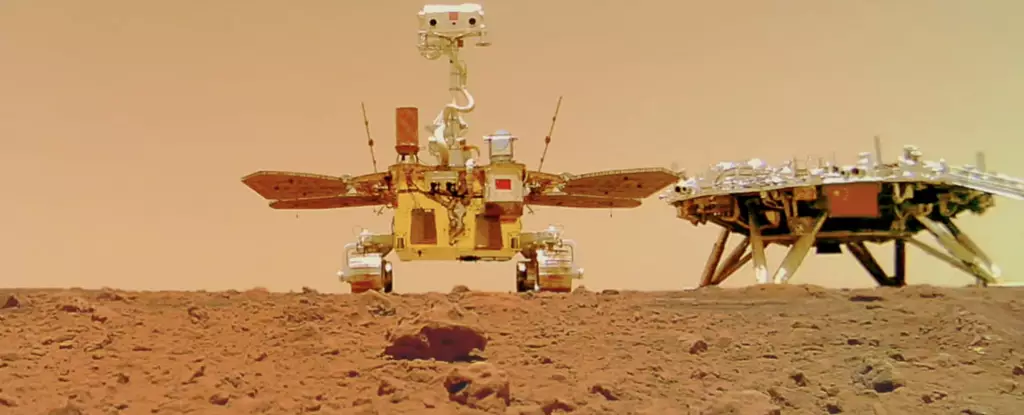China’s Zhurong rover made history as the second successful landing on Mars, following the footsteps of only one other country. Equipped with a ground-penetrating radar system, Zhurong ventured into the Martian surface, uncovering captivating findings. The latest results from the scans of Zhurong’s landing site in Utopia Planitia have revealed irregular polygonal wedges buried at a depth of approximately 35 meters. These enigmatic structures, spanning from centimeters to tens of meters across, have left researchers puzzled as they explore two competing theories: freeze-thaw cycles or volcanic activities. In this article, we delve into the remarkable discoveries made by Zhurong, shedding light on the mysteries of Mars.
China’s Zhurong rover embarked on its mission on May 15, 2021, captivating the world with its enchanting arrival on Mars. Named after a Chinese god of fire, Zhurong explored its landing site and captured breathtaking images, including a remarkable selfie with its lander. The rover diligently studied the topography of Mars, using its ground-penetrating radar (GPR) instrument to conduct insightful measurements. Initially designed for a three-month mission duration, Zhurong surpassed expectations, operating successfully for over one Earth year before entering a planned hibernation. However, the rover fell silent in May 2022, leaving researchers eagerly awaiting signs of life.
The Significance of Zhurong’s Ground-Penetrating Radar
Researchers from the Institute of Geology and Geophysics under the Chinese Academy of Sciences hailed Zhurong’s ground-penetrating radar as a vital complement to orbital radar explorations. By conducting in-situ GPR surveying, the rover provided critical local details of shallow structures and composition within approximately 100-meter depths along its traverse. This GPR data proved instrumental in uncovering the buried polygonal wedges, offering a unique perspective on Mars’ geological history. The combination of orbital and ground exploration has opened new avenues for unraveling the secrets hidden beneath the red planet’s surface.
Utopia Planitia: Illuminating the Martian Terrain
Zhurong’s discoveries in Utopia Planitia, a vast plain within Utopia that marks the largest recognized impact basin on Mars, captivated scientists worldwide. The rover traversed a remarkable distance of 1,921 meters during its operational lifetime. Within this expanse, researchers led by Lei Zhang revealed the presence of sixteen polygonal wedges over a 1.2-kilometer distance, pointing to a widespread distribution of similar terrain beneath Utopia Planitia. These polygonal features likely formed billions of years ago during the Late Hesperian to Early Amazonian epochs on Mars, potentially signaling the cessation of an ancient wet environment. Geological processes subsequently buried this palaeo-polygonal terrain, leaving tantalizing clues for researchers to decipher.
While polygon-type terrain has been observed across various Martian regions during previous missions, the discovery of buried polygon features is entirely novel. The presence of these buried wedges suggests the requirement of a cold environment, potentially linked to water/ice freeze-thaw processes in southern Utopia Planitia during Mars’ early stages. Various explanations have been proposed, including cryogenic suction-induced moisture migration from underground aquifers, snowfall from the air, or vapor diffusion for pore ice deposition. These mechanisms provide fascinating insights into the climatic transformations experienced by Mars. Zhurong’s radar data also revealed multiple layers beneath the surface, indicating the presence of floods that further shaped the landscape of Utopia Planitia.
The Transformation of Mars: Unveiling the Past
The formation of the buried palaeo-polygonal terrain puzzles researchers, as two possible processes emerge: soil contraction from wet sediments drying and producing mud-cracks, or thermal contraction cracking from cooling lava flows. Regardless of the exact mechanism, these findings underscore a dramatic climate change in Mars’ history. The subsurface structure and the presence of covering materials atop the buried polygonal terrain suggest a notable palaeoclimatic transformation in the ensuing years. Unraveling the mysteries surrounding this transformation will undoubtedly fuel further exploration and scientific inquiry.
Zhurong’s remarkable discoveries on Mars have captivated the scientific community and the world at large. The detection of buried polygonal wedges in Utopia Planitia sheds light on Mars’ geological past, potentially signaling the presence of ancient wet environments and significant climatic changes. Zhurong’s ground-penetrating radar has played a crucial role in unraveling the enigmatic secrets hidden beneath the Martian surface. As researchers continue to analyze the data and explore new horizons, the mysteries of Mars slowly unfold, offering glimpses into the Red Planet’s captivating history.


Leave a Reply